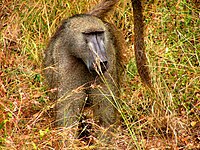Chacma baboon
| Chacma baboon | |
|---|---|
 |
|
| A male gray-footed chacma, one of the subspecies of chacma baboon | |
| Scientific classification | |
| Kingdom: | Animalia |
| Phylum: | Chordata |
| Class: | Mammalia |
| Order: | Primates |
| Family: | Cercopithecidae |
| Genus: | Papio |
| Species: | P. ursinus |
| Binomial name | |
|
Papio ursinus (Kerr, 1792) |
|
| Subspecies | |
|
3 ssp., see text |
|
 |
|
| Geographic range | |
3 ssp., see text
The Chacma baboon (Papio ursinus), also known as the Cape baboon, is, like all other baboons, from the Old World monkey family. It is one of the largest of all monkeys.
Located primarily in southern Africa, the chacma baboon has a wide variety of social behaviors, including a dominance hierarchy, collective foraging, adoption of young by females, and friendship pairings. These behaviors form parts of a complex evolutionary ecology.
In general the species is not threatened, but human population pressure has increased contact between humans and baboons. Hunting, accidents and trapping kill or remove many baboons from the wild. This has reduced baboon numbers and disrupted their social structure.
Due to hybridization between different baboon (Papio) populations across Africa, authors have occasionally grouped the entire radiation as a single species, the hamadryas baboon, Papio hamadryas. Arbitrary boundaries were then used to separate the populations into subspecies. Other authors considered the chacma baboon a subspecies of the yellow baboon, Papio cynocephalus, though it is now recognised as a separate species, Papio ursinus. The chacma baboon has two or three subspecies, depending on which classification is followed. Grubb et al. (2003) listed two subspecies, while Groves (2005) in Mammal Species of the World listed three. This article follows Groves (2005) and describes three distinct subspecies. In the Grubb et al. (2003) paper, P. u. raucana was believed to be synonymous with P. u. ursinus.
The chacma baboon is perhaps the longest species of monkey, with a male body length of 50–115 cm (20–45 in) and tail length of 45–84 cm (18–33 in). It also one of the heaviest; the male weighs from 21 to 45 kg (46 to 99 lb). Baboons are sexually dimorphic, and females are considerably smaller than males. The female chacma weighs from 12 to 25 kg (26 to 55 lb). It is similar in size to the olive baboon and of similar weight to the more compact mandrill, which is usually crowned the largest of all monkeys. The chacma baboon is generally dark brown to gray in color, with a patch of rough hair on the nape of its neck. Unlike the males of northern baboon species (the Guinea, hamadryas, and olive baboons), chacma males do not have a mane. Perhaps the most distinctive feature of this baboon is its long, downward-sloping face. The canine teeth of male chacma baboons have a mean length of 3.86 ± 0.30 cm at the time they emigrate from their natal troop. This is the time of greatest tooth length as the teeth tend to wear or be broken thereafter.
...
Wikipedia

